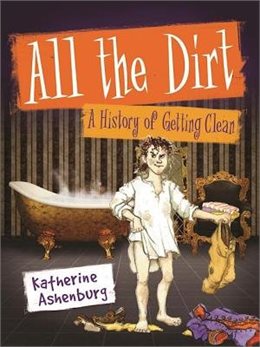| ________________
CM . . .
. Volume XXIII Number 19. . . .January 27, 2017
excerpt:
All the Dirt: A History of Getting Clean takes readers on a fun romp through the ages exploring ideas of cleanliness. Author Katherine Ashenburg weaves together basic history, biology, philosophy, and chemistry in a cohesive and entertaining read. All the Dirt’s introduction addresses eight myths about clean before moving into an historical examination of what it means to be clean. The book spans 3000 BCE to the present, with each chapter focussing on a specific period of time. Most of the chapters focus on European and North American histories, but there are short sidebars from the main narrative that discuss other cultures’ ideas about cleanliness. The chapters begin with a short vignette that sets the scene for readers. These vignettes help readers to immerse themselves in a historical setting. Chapter 2, “Saints, Steam, and Soap: 307 to 1550”, begins with a short, two-page scene in a Constantinople neighbourhood: “Maryam and her mother were going to the neighbourhood hamam or bathhouse. Making her way carefully through the noisy, bustling market, Maryam’s mother carried the henna she had mixed the night before - a vegetable dye she used to keep her hair red-brown - as well as drinks and fruit” (p. 20). While these scenes share facts and new terminology with readers, these facts are integrated into the vignette in a natural and flowing way and help to build out the scene for readers. After the starting scene, the chapter discusses the historical significance of the scene and connects it to information given in previous chapters: “The hamam where Maryam went with her mother may remind you in some ways of the smaller Roman neighbourhood baths” (p. 21). Ashenburg writes in a casual conversational tone, often using second and third person to speak directly to her reader. Her strategy is very successful in livening up what could have been a dull subject matter. Instead, it is as if she is sitting beside the reader telling a story. Her vocabulary choice is rich, appropriately challenging for the recommended reading level (Grades 4-7), while providing opportunities for growing a reader’s vocabulary with words like “civet” and “chinampas”. Because Ashenburg maintains a fast-moving pace, readers may require some time to process and understand the facts. For further exploration, Ashenburg does provide a list of selected readings at the end, with entries that range from scholarly journal articles to popular science books. Written with a Canadian audience in mind, this book does not gloss over the less savoury parts of Canadian history: “In 1855, as part of their attempt to assimilate Native people, the Canadians prohibited sweat lodges… But the sweat lodge was so central to their way of life that many Native people did risk arrest by continuing to build them” (p. 71). While this short passage cannot capture the complexity of these historical events, Ashenburg present these facts in an age-appropriate way within the book’s themes and allows readers to open up a new conversation. Her light-hearted tone throughout the book does not lessen the impact of historical events, but, instead, makes them accessible to pre-teen and young teen readers. Capucine Mazille’s charming and richly coloured illustrations are woven throughout the text with historical sketches, paintings, advertisements, and photographs. Mazille’s sketchy, watercolour-like pictures characters are expressive and cheeky, especially her illustration for the scene in “Nudists and Butter-stinkers” (p. 71), which depicts a group of horrified nineteenth century Western ladies running away from a Japanese gardener bathing outdoors. These humorous illustrations pair well with Ashenburg’s writing style, and the overall effect is a book that appeals to a middle-school audience. All the Dirt wraps up with a look at our society’s changing relationship with microbes and current research findings on our bodies’ microbes. Ashenburg concludes: “The future of cleanliness is a mystery. But one thing seems certain: a century from now, when people with their own ideas look back on what we consider ‘clean’, they will be amused - if not amazed” (p. 101). The book is beautifully produced, with thick glossy pages and a substantial binding that would hold up in any school or public library collection. All the Dirt: A History of Getting Clean is a great addition to any library. Recommended. Sabrina Wong is the Teaching and Outreach Librarian at Capilano University in North Vancouver, BC.
To comment
on this title or this review, send mail to cm@umanitoba.ca.
Copyright © the Manitoba Library Association. Reproduction for personal
use is permitted only if this copyright notice is maintained. Any
other reproduction is prohibited without permission.
Next Review | Table of Contents For This Issue - January 27, 2017 |
